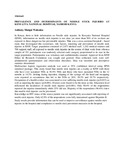| dc.contributor.author | Wainaina, Anthony M | |
| dc.date.accessioned | 2013-11-29T08:10:02Z | |
| dc.date.available | 2013-11-29T08:10:02Z | |
| dc.date.issued | 2013-06 | |
| dc.identifier.citation | Wainaina,Anthony M.,Prevalence And Determinants Of Needle Stick Injuries At Kenyatta National Hospital, Nairobi Kenya,presented at the 2nd International Scientific Conference, Chs And Knh, 19th - 21st June 2013. | en |
| dc.identifier.uri | http://hdl.handle.net/11295/61091 | |
| dc.description | Prevalence And Determinants Of Needle Stick Injuries At Kenyatta National Hospital, Nairobi Kenya, paper presented at the 2nd International Scientific Conference, CHS And KNH, 19th - 21st June 2013. | en |
| dc.description.abstract | In Kenya, there is little information on Needlestick injuries. In Kenyatta National
Hospital (KNH), information on needlestick injuries is not clear yet more than
50% of its workers are exposed to these dangerous but preventable injuries. This
was a cross-sectional hospital – based study that investigated the occurrence,
risk factors, reporting and prevention of needle stick injuries at KNH. Target
population consisted of 2,073 medical staff, 1,242 medical trainees and 768
support staff, all exposed to needlestick injuries in the course of their work
from whom a sample of 351 participants was randomly selected each category
proportional to its size in the target population. Participation was voluntary and
confidentiality ensured. Approval from KNH Ethics & Research Committee was
sought and granted. Data collection tools were self- administered questionnaires
and observation checklists. Data was recorded and descriptive statistics
determined.
Multivariate logistic regression analysis was used at 95% confidence interval
using SPSS statistical package. This study found that needlestick injuries are a
reality at KNH with those who have ever sustained NSIs at 38.0% NSIs and those
who have sustained NSIs in the 12 months at 14.5%. Jerking during injection,
slipping of the syringe off the hand and recapping were reported as occurrences
that led to the NSIs at 26%, 20.3% and 18.7% respectively. Occupation of a
health worker was associated to ever suffering needle stick injuries (p=0.015) as
well as reporting the injury (p<0.001). Doctors were found to be the most at risk.
Education level influenced the incidences of needle stick injuries (p<0.001).
Only 50.4% of the respondents reported the injuries immediately while 35% did
not. Majority of the respondents (96.6%) knew that needlestick injuries can be
prevented.
Knowledge on HIV status of the source patient was not significantly associated
with reporting of needlestick injuries. Only 62.9% of the respondents were fully
immunised against Hepatitis B. Study results provide information that can be
used to improve surveillance against needlestick injuries in the hospital and
compliance to needlestick prevention measures in the hospital. | en |
| dc.language.iso | en | en |
| dc.publisher | University of Nairobi | en |
| dc.title | Prevalence And Determinants Of Needle Stick Injuries At Kenyatta National Hospital, Nairobi Kenya | en |
| dc.type | Presentation | en |
| local.publisher | College of Health Sciences | en |

